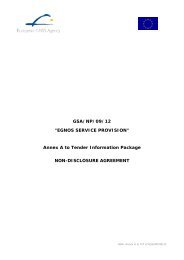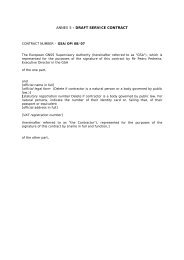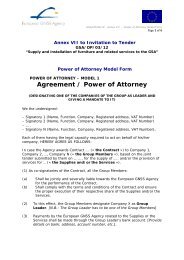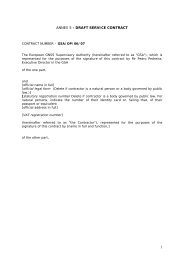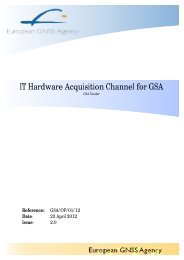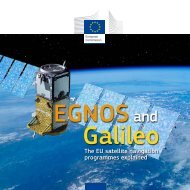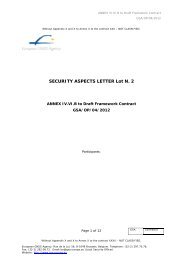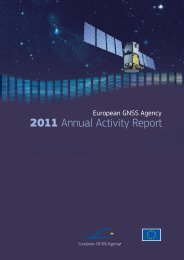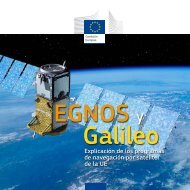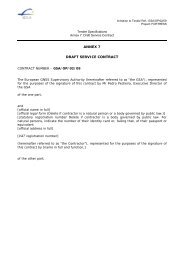Galileo OS SIS ICD.indd - GSA - Europa
Galileo OS SIS ICD.indd - GSA - Europa
Galileo OS SIS ICD.indd - GSA - Europa
You also want an ePaper? Increase the reach of your titles
YUMPU automatically turns print PDFs into web optimized ePapers that Google loves.
leap seconds. Since the next leap second was inserted at 01.01.2006, this implies that<br />
as of 01.01.2006 GST is ahead of UTC by fourteen (14) leap seconds.<br />
The epoch denoted in the navigation messages by TOW and WN will be measured<br />
relative to the leading edge of the fi rst chip of the fi rst code sequence of the fi rst page<br />
symbol. The transmission timing of the navigation message provided through the TOW<br />
is synchronised to each satellite’s version of <strong>Galileo</strong> System Time (GST).<br />
5.1.3. Clock Correction Parameters<br />
The clock correction parameters are transmitted according to the values stated in Table<br />
64.<br />
Parameter Defi nition Bits Scale<br />
factor<br />
Unit<br />
t0c Clock correction data reference Time of Week 14 60 s<br />
a f0 SV clock bias correction coeffi cient 31* 2 -34 s<br />
a f1 SV clock drift correction coeffi cient 21* 2 -46 s/s<br />
a f2 SV clock drift rate correction coeffi cient 6* 2 -59 s/s 2<br />
Total Clock Correction Size 72<br />
Table 64. <strong>Galileo</strong> Clock Correction Parameters<br />
* Parameters so indicated are two’s complement, with the sign bit (+ or -) occupying the MSB.<br />
Each <strong>Galileo</strong> satellite broadcasts its own clock correction data for all signals through<br />
the relevant signal, according to Table 65.<br />
Message<br />
Type<br />
Clock Model<br />
X=(f1,f2)<br />
Satellite Time<br />
Correction Model<br />
Parameters<br />
F/Nav (E1,E5a) af0 (E1,E5a)<br />
af1 (E1,E5a)<br />
af2 (E1,E5a)<br />
t0C (E1,E5a)<br />
I/NAV (E1,E5b) af0 (E1,E5b)<br />
af1 (E1,E5b)<br />
af2 (E1,E5b)<br />
t0C (E1,E5b)<br />
5.1.4. Satellite Time Correction Algorithm<br />
Table 65. <strong>Galileo</strong> Clock Correction Data<br />
© European Union 2010<br />
Document subject to terms of use and disclaimers p. ii-iii<br />
OD <strong>SIS</strong> <strong>ICD</strong>, Issue 1, February 2010<br />
Services<br />
Dual-Frequency (E1,E5a)<br />
Single-frequency E5a<br />
Dual-Frequency (E1,E5b)<br />
Single-frequency E5b<br />
Single-frequency E1<br />
Each satellite transmits time correction data. The predicted offset of the physical<br />
satellite signal TOT relative to the satellite signal TOT in GST can be computed for the<br />
dual frequency signal combination using the following formula:<br />
where<br />
TOT c(X) = TOT m(X) - Δt SV(X) Eq. 12<br />
● (X)=(f 1,f 2) is the dual frequency combination f 1 and f 2 used for the clock model<br />
● TOT C(X) is the corrected satellite TOT in GST for the signal combination X<br />
47



